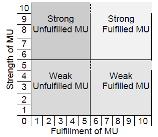Quality of life (QOL) is defined by the World Health Organization as "an individual's perception of their position in life in the context of the culture and value systems in which they live and in relation to their goals, expectations, standards and concerns".
According to the APA Dictionary of Psychology, a feeling is "a self-contained phenomenal experience"; feelings are "subjective, evaluative, and independent of the sensations, thoughts, or images evoking them". The term feeling is closely related to, but not the same as, emotion. Feeling may, for instance, refer to the conscious subjective experience of emotions. The study of subjective experiences is called phenomenology. Psychotherapy generally involves a therapist helping a client understand, articulate, and learn to effectively regulate the client's own feelings, and ultimately to take responsibility for the client's experience of the world. Feelings are sometimes held to be characteristic of embodied consciousness.

Happiness is a complex and multifaceted emotion that encompasses a range of positive feelings, from contentment to intense joy. It is often associated with positive life experiences, such as achieving goals, spending time with loved ones, or engaging in enjoyable activities. However, happiness can also arise spontaneously, without any apparent external cause.
Positive psychology is the scientific study of conditions and processes that contribute to positive psychological states, well-being, positive relationships, and positive institutions.
Self-determination theory (SDT) is a macro theory of human motivation and personality regarding individuals' innate tendencies toward growth and innate psychological needs. It pertains to the motivation behind individuals' choices in the absence of external influences and distractions. SDT focuses on the degree to which human behavior is self-motivated and self-determined.

The economics of happiness or happiness economics is the theoretical, qualitative and quantitative study of happiness and quality of life, including positive and negative affects, well-being, life satisfaction and related concepts – typically tying economics more closely than usual with other social sciences, like sociology and psychology, as well as physical health. It typically treats subjective happiness-related measures, as well as more objective quality of life indices, rather than wealth, income or profit, as something to be maximized.
"Leisure refers to activities that a person voluntarily engages in when they are free from any work, social or familial responsibilities." Leisure satisfaction is the positive perceptions or feelings that an individual forms, elicits and gains as a result of engaging in leisure activities and choices. What can contribute to leisure satisfaction is to what degree an individual is currently satisfied with their leisure experiences and activities. An individual might attain positive feelings of contentment and happiness that result from the satisfaction of needs. Participation in leisure activities and leisure satisfaction are inextricably linked to an individual's health. Caldwell suspects that leisure activities may be associated with a number of defensive traits that enhance a person's resiliency to negative life experiences. Some aspects of leisure activities that can act as protective factors include: "[the activity] being personally meaningful, intrinsically interesting and/or challenging; offering social support and friendships; contributing to a sense of competence and/or self efficacy; offering a sense of personal control, choice and self-determination; and being relaxing and/or distracting the individual from negative life events." Leisure activities, although ranging in types, have also proven to be beneficial to health cross-culturally.
Quality of working life (QWL) describes a person's broader employment-related experience. Various authors and researchers have proposed models of quality of working life – also referred to as quality of worklife – which include a wide range of factors, sometimes classified as "motivator factors" which if present can make the job experience a positive one, and "hygiene factors" which if lacking are more associated with dissatisfaction. A number of rating scales have been developed aiming to measure overall quality of working life or certain aspects thereof. Some publications have drawn attention to the importance of QWL for both employees and employers, and also for national economic performance.
Flourishing, or human flourishing, is the complete goodness of humans in a developmental life-span, that somehow includes positive psychological functioning and positive social functioning, along with other basic goods.
Edward Francis Diener was an American psychologist and author. Diener was a professor of psychology at the University of Utah and the University of Virginia, and Joseph R. Smiley Distinguished Professor Emeritus at the University of Illinois, as well as a senior scientist for the Gallup Organization. He is noted for his three decades of research on happiness, including work on temperament and personality influences on well-being, theories of well-being, income and well-being, cultural influences on well-being, and the measurement of well-being. As shown on Google Scholar as of April 2021, Diener's publications have been cited over 257,000 times.

Well-being is what is ultimately good for a person. Also called welfare and quality of life, it is a measure of how well life is going for someone. It is a central goal of many individual and societal endeavors.
Despite a large body of positive psychological research into the relationship between happiness and productivity, happiness at work has traditionally been seen as a potential by-product of positive outcomes at work, rather than a pathway to business success. Happiness in the workplace is usually dependent on the work environment. During the past two decades, maintaining a level of happiness at work has become more significant and relevant due to the intensification of work caused by economic uncertainty and increase in competition. Nowadays, happiness is viewed by a growing number of scholars and senior executives as one of the major sources of positive outcomes in the workplace. In fact, companies with higher than average employee happiness exhibit better financial performance and customer satisfaction. It is thus beneficial for companies to create and maintain positive work environments and leadership that will contribute to the happiness of their employees.

Extraversion and introversion are a central trait dimension in human personality theory. The terms were introduced into psychology by Carl Jung, though both the popular understanding and current psychological usage are not the same as Jung's original concept. Extraversion tends to be manifested in outgoing, talkative, energetic behavior, whereas introversion is manifested in more reflective and reserved behavior. Jung defined introversion as an "attitude-type characterised by orientation in life through subjective psychic contents", and extraversion as "an attitude-type characterised by concentration of interest on the external object".
Life satisfaction is an evaluation of a person's quality of life. It is assessed in terms of mood, relationship satisfaction, achieved goals, self-concepts, and the self-perceived ability to cope with life. Life satisfaction involves a favorable attitude towards life—rather than an assessment of current feelings. Life satisfaction has been measured in relation to economic standing, degree of education, experiences, residence, and other factors.
Allocentrism is a collectivistic personality attribute whereby people center their attention and actions on other people rather than themselves. It is a psychological dimension which corresponds to the general cultural dimension of collectivism. In fact, allocentrics "believe, feel, and act very much like collectivists do around the world." Allocentric people tend to be interdependent, define themselves in terms of the group that they are part of, and behave according to that group's cultural norms. They tend to have a sense of duty and share beliefs with other allocentrics among their in-group. Allocentric people appear to see themselves as an extension of their in-group and allow their own goals to be subsumed by the in-group's goals. Additionally, allocentrism has been defined as giving priority to the collective self over the private self, particularly if these two selves happen to come into conflict.
Subjective well-being (SWB) is a self-reported measure of well-being, typically obtained by questionnaire.
The six-factor model of psychological well-being is a theory developed by Carol Ryff that determines six factors that contribute to an individual's psychological well-being, contentment, and happiness. Psychological well-being consists of self-acceptance, positive relationships with others, autonomy, environmental mastery, a feeling of purpose and meaning in life, and personal growth and development. Psychological well-being is attained by achieving a state of balance affected by both challenging and rewarding life events.
Cultural differences can interact with positive psychology to create great variation, potentially impacting positive psychology interventions. Culture differences have an impact on the interventions of positive psychology. Culture influences how people seek psychological help, their definitions of social structure, and coping strategies. Cross cultural positive psychology is the application of the main themes of positive psychology from cross-cultural or multicultural perspectives.
Aversion to happiness, also called fear of happiness, refers to "the subjective experience of negative affect when experiencing or expressing happiness, which stems from the belief that happiness may lead to negative consequences". It is an attitude towards happiness in which individuals may deliberately avoid experiences that invoke positive emotions or happiness. Aversion to happiness is not a recognized mental health disorder on its own, but it can contribute to and/or exacerbate existing mental health issues.
Well-being is a multifaceted topic studied in psychology, especially positive psychology. Biologically, well-being is highly influenced by endogenous molecules that impact happiness and euphoria in organisms, often referred to as "well-being related markers". Related concepts are eudaimonia, happiness, flourishing, quality of life, contentment, and meaningful life.






